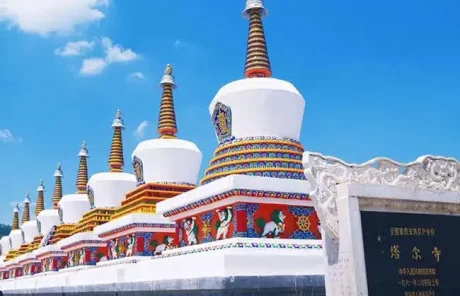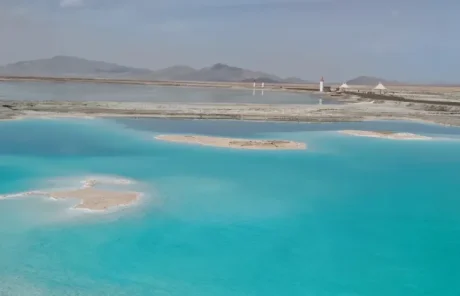Qinghai Travel Guide: Ultimate Guide to Exploring Qinghai
Located in western China and the northeastern Qinghai-Tibet Plateau, Qinghai borders Gansu, Sichuan, Tibet, and Xinjiang. Named after Qinghai Lake, the largest inland saltwater lake in China, Qinghai covers a vast area of mountains and plateaus with an average elevation of about 3,000 meters. It is the source of the Yangtze River, Yellow River, and Lancang River, earning it the titles “Source of Three Rivers” and “China’s Water Tower.”
Qinghai Province is rich in natural landscapes and cultural relics. Scenic attractions like Qinghai Lake, Chala Salt Lake, and the Kunlun Mountains attract many tourists from home and abroad. As a cultural melting pot, Qinghai is home to many ethnic groups, including Tibetans, Hui, Mongols, Tu, and Salar. Besides, it boasts a rich history of Buddhism and Tibetan culture, which can be found when you tour Ta’er Monastery, Kumbum Stupa, and Yushu Tibetan Autonomous Prefecture.

Chinese: 青海 qīng hǎi
Location: Northwest China
Population (urban area): 5,950,000
Why Visit Qinghai
- Breathtaking scenery:Qinghai greets visitors with stunning scenery. Far more than Qinghai Lake and Chaka Salt Lake, it boasts vast grasslands, soaring mountains, pristine lakes, and unique geological formations.
- Cultural diversity:Qinghai is home to five main minority groups, including Tibetans, Hui, Mongols, Tu, and Salar. It offers a good opportunity for you to experience cultures of the minorities. Besides, you can also catch a glimpse of the influence of the ancient Silk Road
- Outdoor activities:Qinghai offers many outdoor activities for adventure enthusiasts for its vast grasslands, steep mountains, and beautiful lakes. Visiting there, you can enjoy hiking, camping, cycling, and horseback riding.
- DeliciousQinghai cuisine: Qinghai treats visitors with a wide range of delicious food of unique flavors and ingredients, including yak meat, hand-grabbed mutton, and Tibetan butter tea.
- Authentic travel experience:Qinghai covers a huge area with less population. If you are tired of life in metropolises and want to escape the crowds, visit Qinghai; and you will enjoy a more authentic travel experience and a slower pace of life.
Top Qinghai Tourist Attractions
Kanbula National Forest Park
Surrounded by the Yellow River reservoir, this scenic park of Qinghai mainly features the Danxia landform, of which the towering red cliffs contrast beautifully with the emerald-green water, creating breathtaking landscapes.
Top Things to Do in Qinghai
1. Explore Qinghai Lake
Being the largest saltwater lake and inland lake in China, this beautiful lake covers an area of 4,583 square kilometers with a shoreline stretching 320 kilometers. Surrounded by alpines and mountains, it is home to diverse wild birds, including black-necked cranes, cormorants, whooper swans, and other rare species of birds. Besides, on your tour of Qinghai Lake, you’ll find a desert to the east of it, which is ideal for hiking and camping.
2. Visit Ta’er Monastery
Located in Xining of Qinghai in China, this is a Tibetan monastery with a long history, and the cultural heritage like architecture, Buddhist statues, vessels, and collections of books make it a treasure house of art. The most significant is its three artistic wonders, Yak Butter Sculptures, Murals, and Barbola, which attract numerous visitors.
3. Marvel at Chaka Salt Lake
Used to be an important point of the ancient Silk Road in China, Chaka Salt Lake is called the “East Gate of Qaidam Basin”. Surrounded by snow-capped mountains, this lake is like a mirror reflecting the charming scenery of the sky, so it is called the “Mirror of the Sky in China”. It is an ideal place for you to marvel at the natural beauty of Qinghai on your Silk Road trip.
4. Getting Close to Wildlife
There is no doubt that Qinghai is a perfect place for you to get close to wildlife and observe them on your Qinghai tours. Owing to its landscapes and climate, Qinghai Province of China houses a variety of wildlife, including Tibetan antelopes, wild yaks, and birds of prey. Even on the road, you will see yaks eating grass on the green grassland.
5. Experience Tibetan Culture
China’s Qinghai Province is home to many Tibetan communities, and you can visit Tibetan residents to taste the specialties, learn about Tibetan music and dance, and experience traditional Tibetan culture. Moreover, you can visit the Qinghai Tibetan Cultural Museum on your Silk Road tour to explore more about Tibetan medicine, arts, and religion.

Qinghai Weather
Qinghai is situated on the Qinghai-Tibet Plateau and far from the ocean, which gives it a highland continental climate characterized by long sunshine hours and strong radiation together with a significant difference in day and night temperatures. It has cool summers and long freezing winters. Other than this, the region experiences low annual precipitation, with most of the rainfall occurring during the summer months.
Best Time to Visit Qinghai
The best time to visit Qinghai is from May to October. Spring endows this land with green grasslands and blooming flowers, summer treats visitors with clear water and blue sky, and autumn turns this region into a colorful magical world. It’s cold outside in winter, but if you prefer skiing, you can visit there then.

Qinghai Transportation
Getting to Qinghai
Xining is the capital of Qinghai Province. To travel to Qinghai, an optional choice is to get to Xining first. You can take a flight to Qinghai’s Xining Caojiabao Airport from major cities in China like Beijing and Shanghai. If you prefer to travel by train, then take a train to Xining, where the Qinghai Tibet Railway starts. Besides, if you are from nearby cities like Haidong, Yushu, and Golmud, you can get there by bus.
Getting around Qinghai
It’s convenient for you to take buses to get around Qinghai. From Xining Bus Station, you can take a bus to Qinghai Lake and Chaka Salt Lake. Besides, if you prefer a more private and faster tour, you can hire a taxi at Xining in Qinghai.









